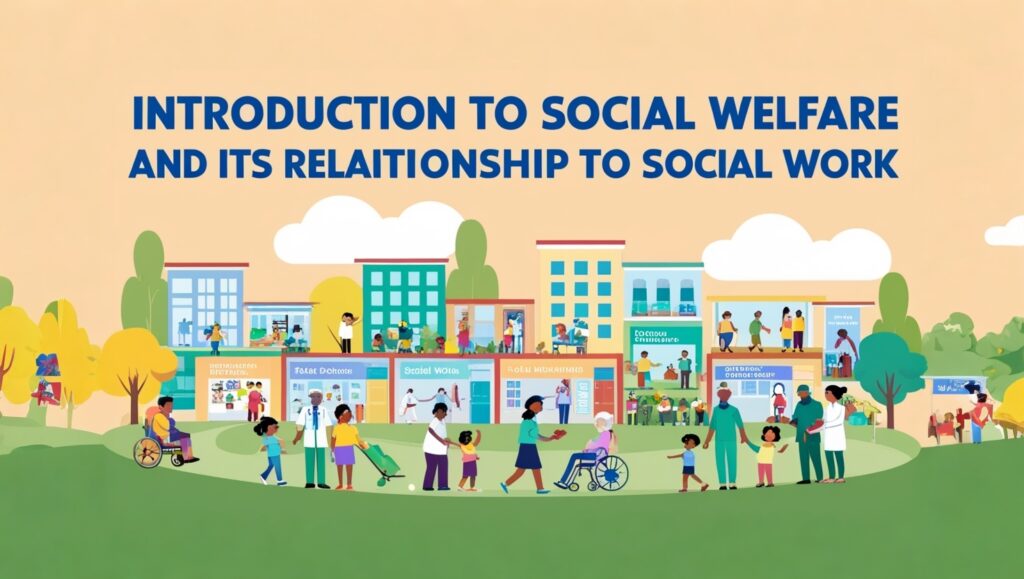Introduction to Social Welfare
The term “social welfare” denotes the system of such services that intend to cater to the special needs of persons, groups, and communities who, because of some handicap—social, economic, mental, or physical are unable to avail themselves of, or are traditionally denied the basic amenities or services provided by the society or state.
It implies that social welfare services are meant to benefit the weaker, dependent, or underprivileged sections of the population. Such services cover the needy members of society, like orphan children, widows, destitute, mentally retarded persons, the blind, the deaf, the crippled, and other economically underprivileged members of society.
Social welfare constitutes special services for meeting the special needs of people in a special population category. Services under social welfare do not form part of general social services provided to all citizens without any special consideration. For example, public health, education, recreational activities, medical relief, etc, are general in nature.
The services under social welfare aim to enable marginalized people to absorb the general social services and share the fruits of economic development in society. Shortly speaking, social welfare refers to the collective responsibility to meet the needs of all the people in general and the needy and marginalized in particular.

Definitions of Social Welfare
- The National Association of Social Workers (the primary professional organization for social workers). Social welfare is “a nation’s system of programs, benefits, and services that help people meet those social, economic, educational, and health needs that are fundamental to the maintenance of society.”
- According to Encyclopedia Britannica, social welfare has been defined as “a system of laws and institutions through which a government attempts to protect and promote the social and economic welfare of its citizens, usually based on various forms of social insurance against unemployment, accident, illness, and old age.”
- Walter A. Friedlander said, “Social welfare is the organized form of social services and institutions, designed to aid individuals and groups to attain satisfying standards of life and health, and personal and social relationships that permit them to develop their full capacities and to promote their well-being in harmony with the needs of their families and the community.”
- United Nations on social welfare planning in the context of National Development plans defined social welfare as “a body of organized activities which are basically meant to enable individuals, groups, and communities to improve their own situations, adjust to changing conditions and participate in the tasks of development.”
- Ronald C. Federico defined “Social welfare as a society’s governmental and non-governmental efforts to help its members function more effectively as individuals and as participants in organized social structures.”
- Elizabeth Wickenden defines social welfare as “including those laws, programs, benefits, and services which assure or strengthen provisions for meeting social needs recognized as basic to the well-being of the population and better functioning of social order.”
- Donald S. Howard believes that “Social welfare has been especially identified with the improvement of conditions of life, physically, mentally, emotionally, economically, or socially handicapped or otherwise disadvantaged individuals or groups.”
Objectives of Social Welfare
The main objective of social welfare is to create the basic conditions that will enable all members of the community to realize their potential for growth and self-fulfillment. The principle of normalization is fundamental to the social welfare goals. Regardless of physical, psychological, or social handicaps, a person should be able to live, work, and develop in a normal environment.
There are the following major objectives of social welfare:
- To ensure adequate living standards for all
- To ensure social justice for all
- To provide opportunities for cultural development through individual group self-expression.
- To readjust human relations, leading to social harmony.
Specific Objectives
- To find homes for children without parents.
- To support individuals in overcoming their addiction to alcohol or drugs.
- To support individuals facing emotional challenges.
- To enhance the quality of life for older adults.
- To offer vocational and rehabilitation services to individuals experiencing physical or mental disabilities.
- To address the financial needs of individuals experiencing poverty.
- To support the rehabilitation of juveniles and adults who have engaged in criminal behavior.
- To eliminate all forms of discrimination and oppression.
- To provide child care services for parents who work outside the home.
- To counter violence in families, including child abuse and spouse abuse.
- To fulfill the health and legal demands of those in financial need.
- To counsel individuals and groups experiencing various personal and social difficulties.
- To provide recreational and leisure-time services to all age groups.
- To educate and provide socialization experiences to children who have a cognitive disability or an emotional disorder.
- To serve families struck by such physical disasters as floods, earthquakes, fires, etc.
- To provide adequate housing for the homeless.
- To provide programs that support and enhance all children and adults’ normal growth and development.
- To offer vocational training and create employment opportunities for individuals who are unskilled and unemployed.
- To meet the special needs of people of race, migrants, and other minority groups.
- To empower individuals, groups, families, organizations, and communities to improve their circumstances.
Goals of Social Welfare
- Expansion of social services and their improvement.
- To offer support services and enhance the well-being of the marginalized and vulnerable population.
- To develop supplementary welfare services.
- To bring about social reform.
- To provide social security and social assistance.
- To bring about social change, including reducing disparities in income and wealth.
- To prevent the concentration of economic power and take steps to equalize opportunities within the communities.
- To help individuals attain satisfying standards of life, health, and equal opportunities with fellow citizens and self-respect.
- To secure the basic economic requirements and decent living conditions for each individual.
- To strengthen individual capacities to cope with the real-life situation.
- To create the basic condition that will enable all the community members to realize their potential capacity, growth, and self-fulfillment.
Dimensions of Social Welfare
Social welfare has different meanings, as it is aninstitution and anacademic discipline.
As an Institution
Social welfare programs and social service organizations are sometimes called “social welfare institutions.” The purposes of social welfare institutions are to prevent, alleviate, or contribute to the solution of recognized social problems to directly improve the well-being of individuals, groups, families, organizations, and communities. Social welfare institutions are established by policies and laws, with the programs and services provided by voluntary (private) and governmental (public) agencies.
The term social welfare institution is applied to various levels of complexity and abstraction. It may be applied to a single program or organization—for example, foster care or planned parenthood. The term may be applied to a group of services or programs. For example, child welfare services are social welfare institutions that include services such as adoption, foster care, juvenile probation, protective services, runaway services, daycare, school social services, and residential treatment.
As an Academic Discipline
Another interpretation of social welfare comes from its function as an area of study. In this context, social welfare refers to the examination of organizations, programs, staff, and regulations that concentrate on providing social services to individuals, groups, and communities. One of the functions of the social welfare discipline is to educate and train social workers. Some colleges and universities call their professional preparation programs for social work practice “social work,” and others call their programs “social welfare.”
Social Welfare’s Relationship to Social Work
How are social welfare and social work related? The goal of social work is the welfare of the underprivileged section of society. With this view, social welfare is a goal, while social work is a process to achieve that goal. Simply put, social work improves people’s social and economic welfare. Social welfare is a broader concept that includes social work within its scope. The connection between social welfare and social work is fundamentally rooted in practical application. The practice of social work involves the professional use of values, principles, and techniques aimed at achieving one or more specific goals.
- Assisting individuals in accessing essential services.
- Offering support and therapeutic guidance to individuals, families, and groups.
- Supporting communities or groups in enhancing or delivering social and health services.
- Engaging in related legislative activities.
- Understanding human development and behavior, along with the social, economic, and cultural institutions, is essential in this field, as well as recognizing how these elements interact with one another.
The National Association of Social Workers has defined the term social worker as “Individuals who have completed their graduation in social work, whether at the bachelor’s or master’s level, apply their expertise to offer essential social services to a diverse range of clients, including individuals, families, groups, communities, organizations, and society as a whole.”
Social workers support individuals in enhancing their abilities to address challenges and manage stress. They assist in accessing essential resources, promote meaningful connections among individuals and their surroundings, hold organizations accountable to the community, and advocate for changes in social policies.

Almost all social workers are working in the field of social welfare. However, many other professional and occupational groups may be working in this field, as illustrated in the above-mentioned Figure: Professional people providing social welfare services.
Controversy about Social Welfare
Social welfare can be quite controversial on two counts. One involves individuals’ responsibility to care for themselves independently of government, reflecting the old saying, “You get what you deserve.” The other concerns society’s responsibility to care for all its members, especially those of oppressed groups. There is constant political debate about what social services should and should not be provided and about who should receive them and who should not.






